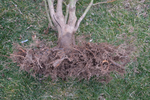Waldo
Yamadori
Thanks for any suggestions.

Thanks Shibui, I have a couple of shots, front and back, better depicting the nebari. Let me know your thoughts.It is hard to give good advice without a good look at the problem in question. I'm having trouble getting a good look at the nebari in that photo. Maybe some closer, clearer pics would help.
Whether to remove roots or not depends on what is underneath. Well spread and even roots gives us good nebari. If some individual high or crooked roots don't look good and there are better roots below then just remove the wayward ones. most trees have plenty of spare roots and will rarely miss a beat when a few roots are cut.
It becomes more complicated when there are no better roots below the ones you want to remove. That's when you need to consider root replacement therapy



Thanks Japonicus, I really don't have much wire on the tree. I want to just leave it grow. I have cleaned it up, hoping for more back budding this spring. Needed to get more light to the trunk . I will re-evaluate in spring and make decisions then.Your wiring needs a little help though...as does mine often
add this free class to cart (not free trial button) and check out
So if you don't link yet from trusted members, that's cool, just go to shop.mybluprint.com
Bonsai Wiring Essentials
Uncover professional secrets to wiring better, faster and more accurately in this FREE mini-class, and develop beautiful bonsai trees!shop.mybluprint.com
and search for Bonsai Wiring Essentials, add free class to cart and check out. It's free no spam either.
I'm the worlds worst for that. You're right. I found wire grown over by the nebariLooks like they should be left.
But not like that.
It seems the wire has been destroying them.
That's gonna effect how well they look in the future.
Sorce


The problem here is the was the tree has been poorly potted in the past. See how it’s mounded up? And the soil has eroded away, leaving those exposed roots?Thanks Shibui, I have a couple of shots, front and back, better depicting the nebari. Let me know your thoughts. View attachment 268529View attachment 268531View attachment 268529
My JWP (on BP roots) nebari mounds up. Behoves me ∆The problem here is the was the tree has been poorly potted in the past. See how it’s mounded up? And the soil has eroded away, leaving those exposed roots?
That’s why the proper way is to pot with the nebari level to the surface of the soil, and the soil should be level in the pot. There’s no erosion, and surface roots will grow out horizontal rather than down like a cone.
It becomes more complicated when there are no better roots below the ones you want to remove. That's when you need to consider root replacement therapy. This is of course the entire issue in a nut shell, you don't know what's below those little stragglers that masquerade as surface roots. I would bet there are many more roots below those in question. I have had trees like this and have never hesitated to cut them.It is hard to give good advice without a good look at the problem in question. I'm having trouble getting a good look at the nebari in that photo. Maybe some closer, clearer pics would help.
Whether to remove roots or not depends on what is underneath. Well spread and even roots gives us good nebari. If some individual high or crooked roots don't look good and there are better roots below then just remove the wayward ones. most trees have plenty of spare roots and will rarely miss a beat when a few roots are cut.
It becomes more complicated when there are no better roots below the ones you want to remove. That's when you need to consider root replacement therapy
I think that with expert repotting (half bare root repot), some detangling, some pruning, that over a couple of years and a couple of repots the nebari can be improved.It becomes more complicated when there are no better roots below the ones you want to remove. That's when you need to consider root replacement therapy. This is of course the entire issue in a nut shell, you don't know what's below those little stragglers that masquerade as surface roots. I would bet there are many more roots below those in question. I have had trees like this and have never hesitated to cut them.
